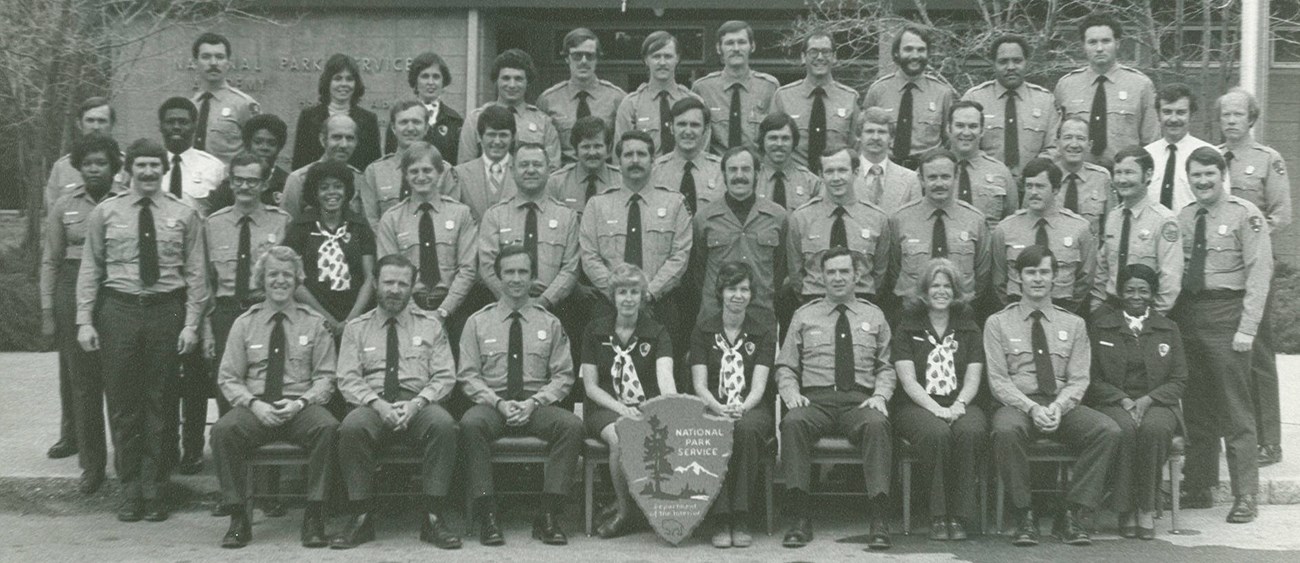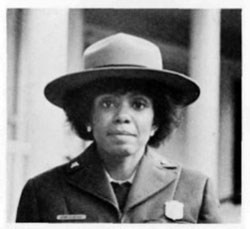Last updated: March 1, 2022
Article
Diane Harris Dayson
Diane Harris was practically born into the National Park Service (NPS). Her father, Robert Harris, worked in maintenance at several national park sites in the New York area throughout his 30-year career. He hoped that at least one of his five children would follow him into the NPS. When she was in high school he pushed her to take a summer job as a cashier at a concession stand at Statue of Liberty National Monument. In an Asbury Park Press article published in 2000, she recalls how she was uninvested in the work at the time and that she “wanted something different.” In spite of her early reluctance, she eventually found that “the Park Service was in [her] blood.”
She graduated with a BA in education and American history from the State University of New York at Cortland in 1975. At her father’s urging she looked to the NPS for job opportunities. She got her foot in the door in May 1975 with a 180-day appointment as a park technician in public involvement at Gateway National Recreation Area.
She took a clerk-typist position at Gateway in April 1976 but quickly worked her way out of the clerical role. In March 1977, she was accepted into the ranger intake training program which was designed to give employees the skills and experience to eventually move into management positions. Almost immediately she was sent to NPS operations training at Albright Training Center at Grand Canyon National Park. She recalled in a 1985 oral history interview that she "cried all the way out there," acknowledging that she was afraid and didn't know what to expect during the two-month training course. For a woman who grew up in the city, life in a remote national park was a culture shock.

Although she became close with her 39 classmates and described the men in the class as supportive, the five women were sometimes treated differently by the instructors. They were given opportunities to avoid tasks like camping, climbing, or repelling. Harris recalled, "They'd try not to say 'women' but they would be looking straight at the women" when they offered the choice to decline. "Every time they gave me that option it was more of a challenge, and it was a need to go ahead and do it. So I just did it."
She continued her intake training program at Boston National Historical Park in May 1977 as a law enforcement ranger. She experienced "overt racism" at Charles Town Navy Yard and wanted to leave after a week. She recalled that her supervisor felt that only white men should be in law enforcement. With support and advice from NPS regional office staff and her father, she stuck with it and learned to fight for what she wanted. Eventually her supervisor became a valued mentor.
Harris transferred to Gateway's Sandy Hook unit in September 1978, as a law enforcement ranger and acting concession specialist. By December, she completed law enforcement training at the Federal Law Enforcement Training Center (FLETC) in Glynco, Georgia. She was the only Black woman in her class.
She married Kevin Dayson in 1978, becoming Diane H. Dayson. She left the NPS for several years to have a family.
Around June 1985, Dayson returned to the NPS as site manager for Hamilton Grange National Monument and General Grant National Memorial. In October 1987, she began an acting superintendent assignment at Sagamore Hill National Historic Site and became the superintendent the following February. As superintendent, Dayson promoted and implemented policies addressing sensitive historic preservation issues. She held the position until June 1990 when she became superintendent at Morristown National Historical Park. By 1994, Dayson was superintendent of Roosevelt-Vanderbilt National Historic Site.
Throughout her career, Dayson was praised for generating new interest in the parks where she worked and preserving their historic resources by reaching out and connecting with the community. She recalled, “As a Black woman, I’ve always felt the challenge of having to work harder than others. I feel strongly, however, that hard work, ability, and professionalism can and will overcome stereotypes. I’ve worked hard to be judged not as a woman or a Black but on my qualifications, and I have been successful."

In 1996, returning to where it began for her as a high school student, Dayson became superintendent of Statue of Liberty National Monument, the first Black woman to hold the position. She managed a $20 million budget and a staff of 200 employees and 100 volunteers. She inherited 29 crumbling buildings on Ellis Island and worked with groups interested in raising funds for their preservation.
In a July 2, 2000, interview in the Herald News, she noted that her achievements came with “a lot of challenges. There was a long road to go down to accomplish these goals. I had come into an organization that was traditionally dominated by white males. So there were definitely some glass ceilings I had to deal with.” She also noted that her goal was to “continue to make a difference, to get into a higher position at the Park Service and to become a representative for minorities and women.” In 2000 she earned an MS in management from New York University.
Dayson was superintendent during the September 11, 2001, terrorist attacks. In fact, it was her first day back at the park after an eight-month absence for the senior executive service career development program in Washington, DC. In an oral history interview four months later she recalled, “Once I entered the park and realized what was going on, then I had no time to be horrified or upset. I immediately had to go into a role that showed true leadership and management style. That was a challenge that was brought upon me. And my law enforcement background from my past with the National Park Service came into being immediately. My biggest concern was for the employees because the sites were not open yet to the public but getting the employees safely off the island so that they could get home to their families.” Dayson remained on Ellis Island, even though her husband and children couldn’t contact her due to the communication outages following the attack.
She worked with US Park Police and other first responders as the park became a triage site for people evacuated from Lower Manhattan. The staff of 20 assisted about 350 people that day. She recalled, “I spent most of my time right out there in the heart of everything that was going on. I felt it was necessary for me to be out there with the staff, providing them with the necessary support that they needed.” Dayson also dealt with the aftermath of the attacks, including increased security for the iconic park, public reaction to an extended closure of the statue itself, and the impact on her staff. She recalled, “I felt like I was carrying that burden because this is an international icon, and here we are trying to service people and I’m trying to take care of staff at the same time. Immediately after I recognized that we needed to bring in peer support counseling for the staff so that [they] had people to talk to and to deal with their fears as they began to come back to work after 9/11.”
Managing an iconic park after 9/11 also brought new challenges and stresses. She recalled, “My emotion and my frustration and my stress level got extremely high, not during the incident itself, not two or three days later, not a week later, but three or four weeks later when I had to deal with the level of bureaucracy that I had to deal with relative to getting this site back open.” She retired from the NPS in October 2003 but didn’t slow down. In 2010 she earned a PhD in Public Policy and Administration from Walden University. She also got her chance to teach in a classroom. Since 2011 she has been part-time faculty for Capella University and an instructor at the University of Fairfax.
Sources:
Ancestry.com. (2010). U.S., Public Records Index, 1950-1993, Volume 1 [database on-line]. Lehi, UT, USA: Ancestry.com Operations, Inc.
"Diane Dayson, Ph.D." (2021). https://www.linkedin.com/in/diane-dayson-ph-d-49aba916 accessed December 29.
Diane Dayson interview with Polly Kaufman (1985, March 19). The Polly Kaufman Collection at the NPS History Collection, Harpers Ferry Center.
"Lady Liberty Shines on First Black Female Superintendent.” (2000, July 24). “The Herald-News, pp. 14.
Landry, C. (2000, July 23). “Superintendent feeling at home on Ellis Island.” Ashbury Park Press, pp. 3.
Mahabir, K. (1994, August 12). “Mansion deteriorates while money is tight.” Poughkeepsie Journal, pp. 1A.
National Park Service. (1985, June). “Dayson to Grant, Hamilton Grange Memorials.” Courier, 30 (6), 7.
National Park Service. (1988, February). “Profiles.” Courier, 33 (2), 37.
National Park Service. (1991). Historic Listing of National Park Service Officials. US Government Printing Office, Washington, DC.
National Park Service. (2002). Diane Dayson, January 28, 2002. September 11, 2001 Oral History Project, 2001-2004. NPS Oral History Collection (HFCA 1817), Harpers Ferry Center.
“New Head for Morris Park.” (1990, July 14). Daily Record, p. 13.
Explore More!
To learn more about Women and the NPS Uniform, visit Dressing the Part: A Portfolio of Women's History in the NPS.
This research was made possible in part by a grant from the National Park Foundation.
Tags
- boston national historical park
- eleanor roosevelt national historic site
- ellis island part of statue of liberty national monument
- gateway national recreation area
- general grant national memorial
- hamilton grange national memorial
- home of franklin d roosevelt national historic site
- morristown national historical park
- national parks of new york harbor
- sagamore hill national historic site
- women’s history
- african american history
- hfc
- nps history
- nps history collection
- nps careers
- 9/11
